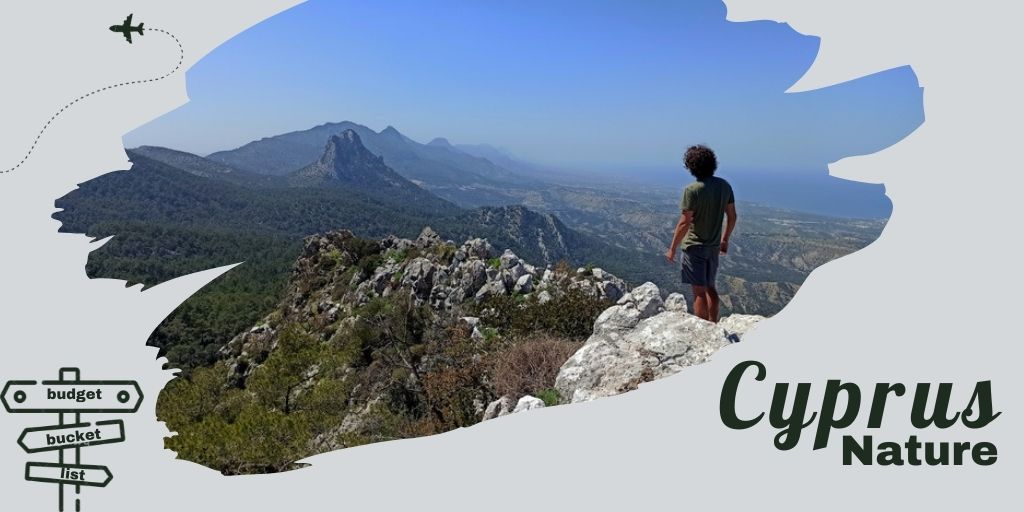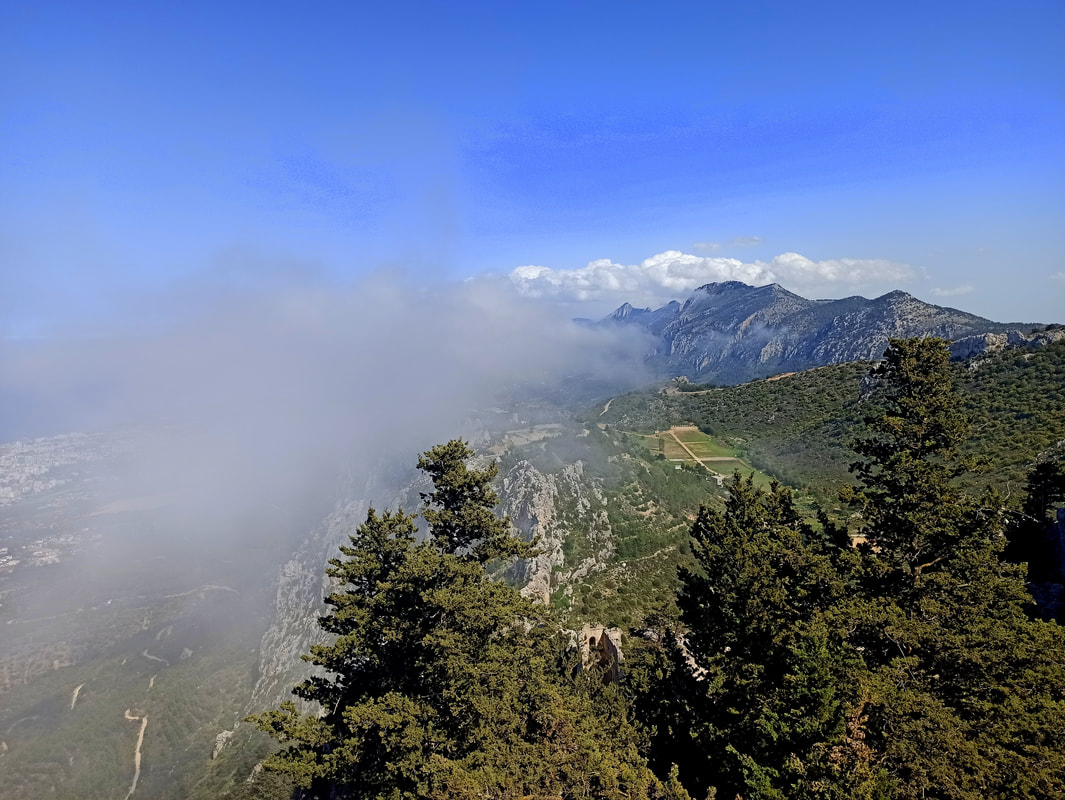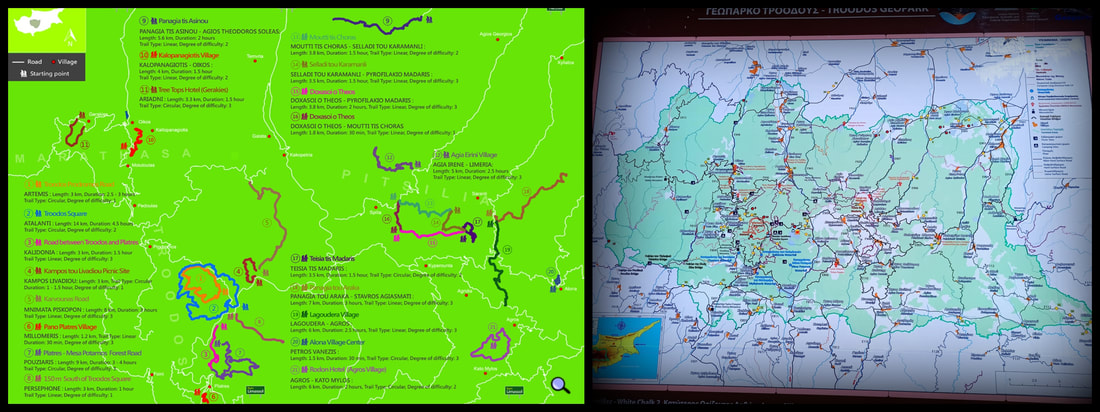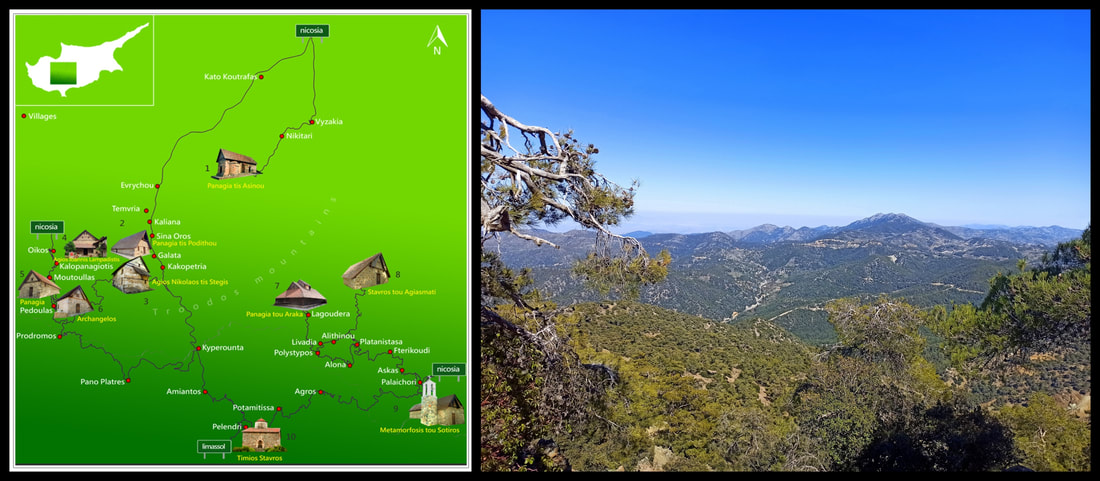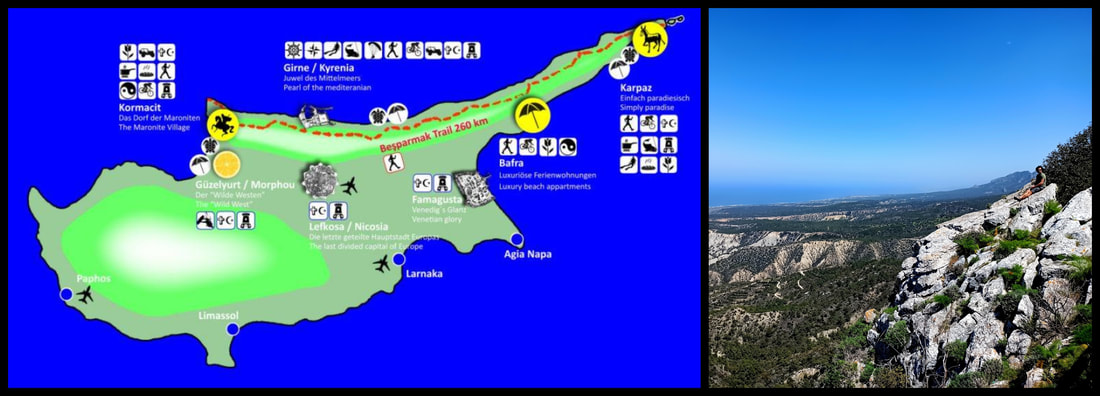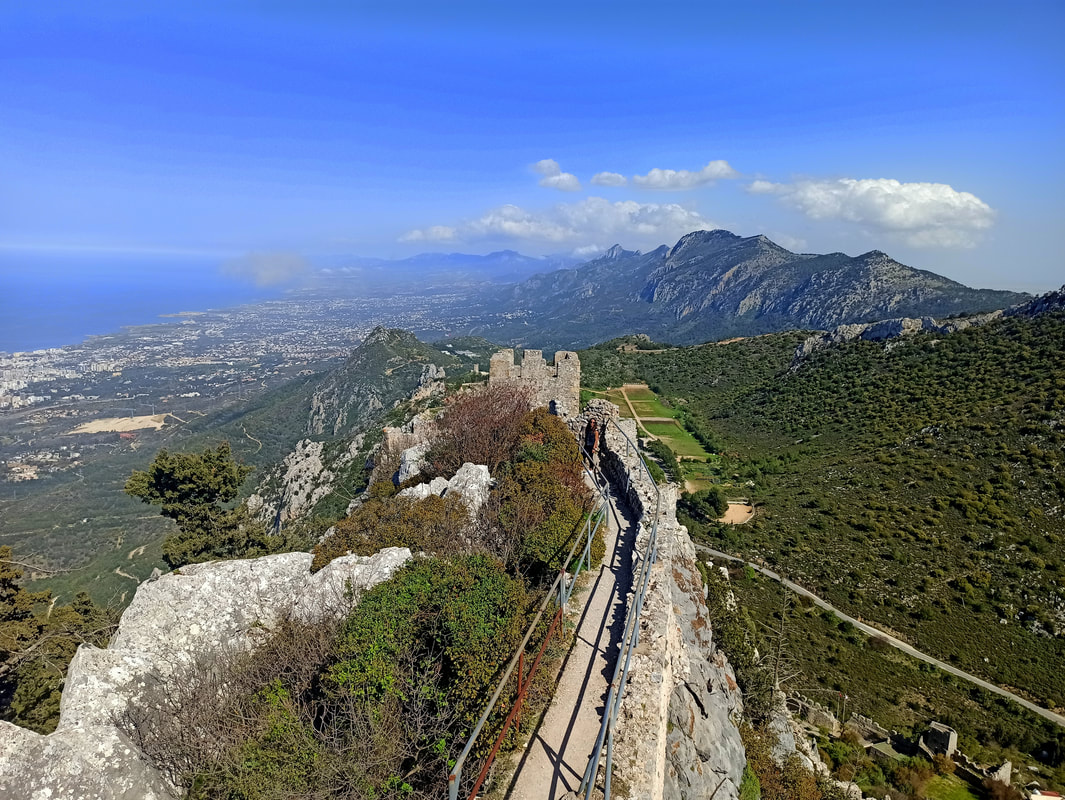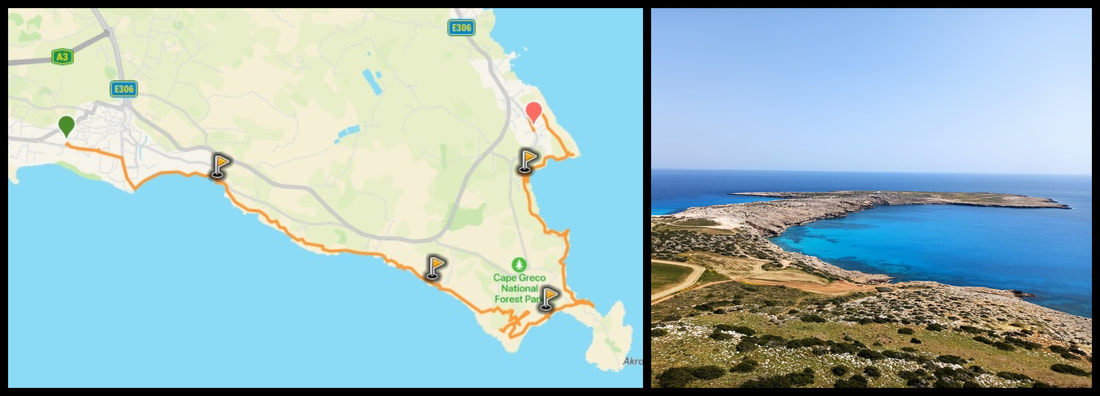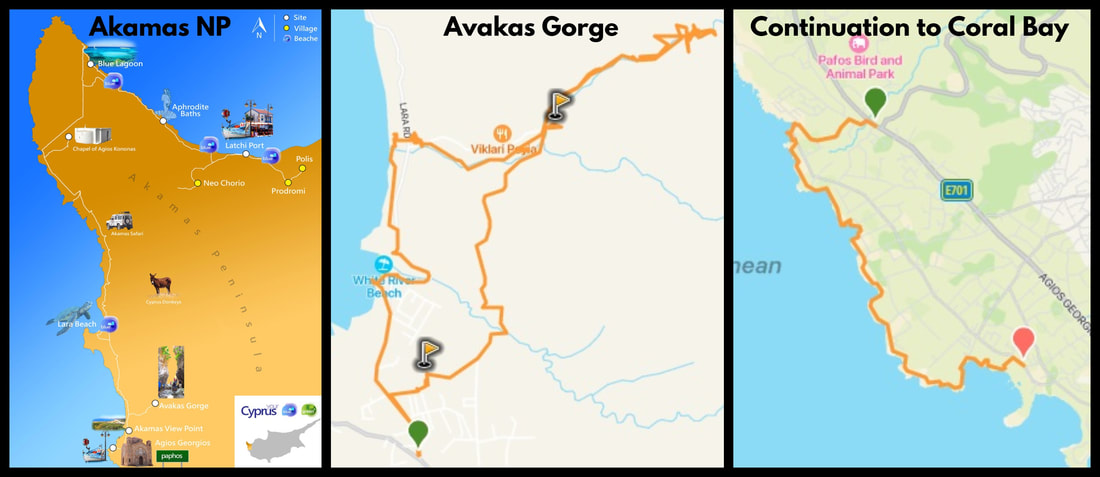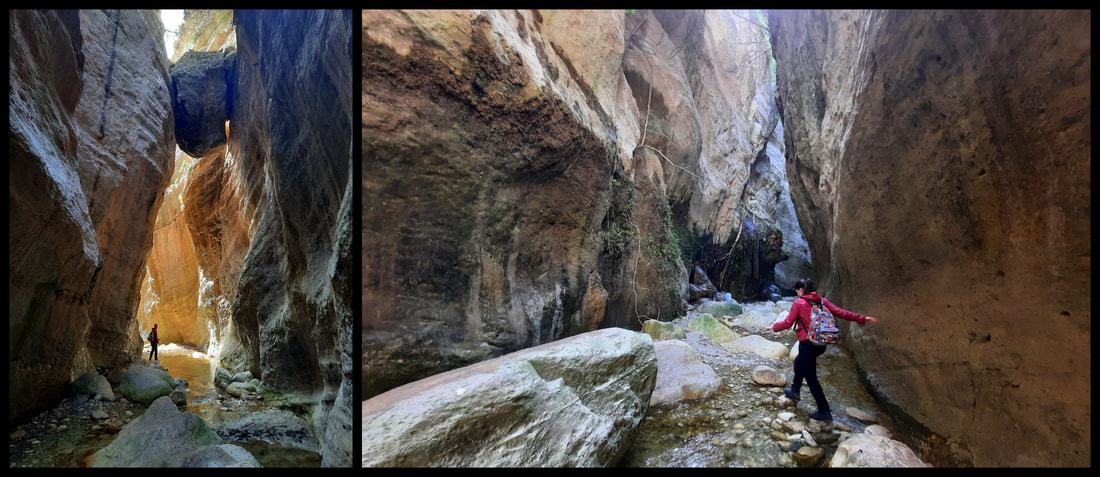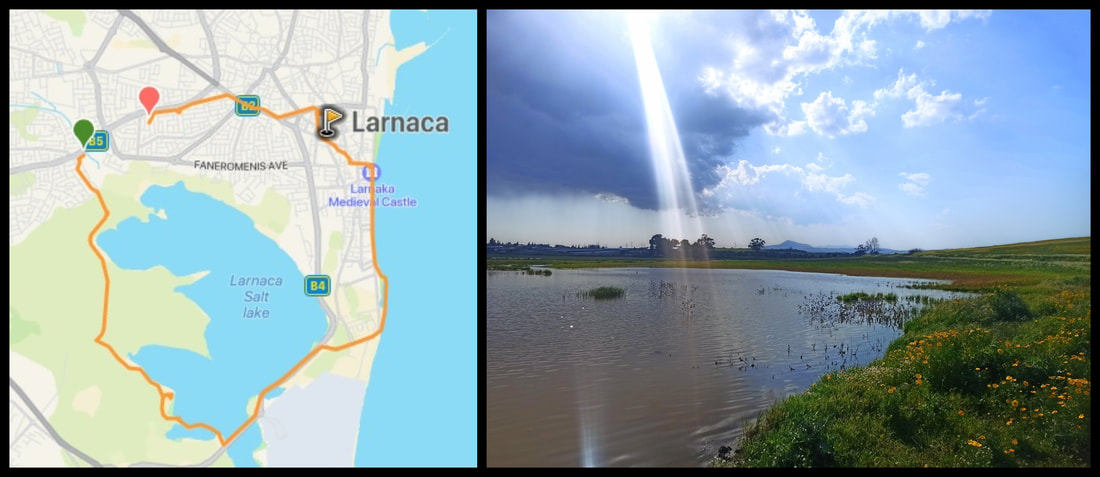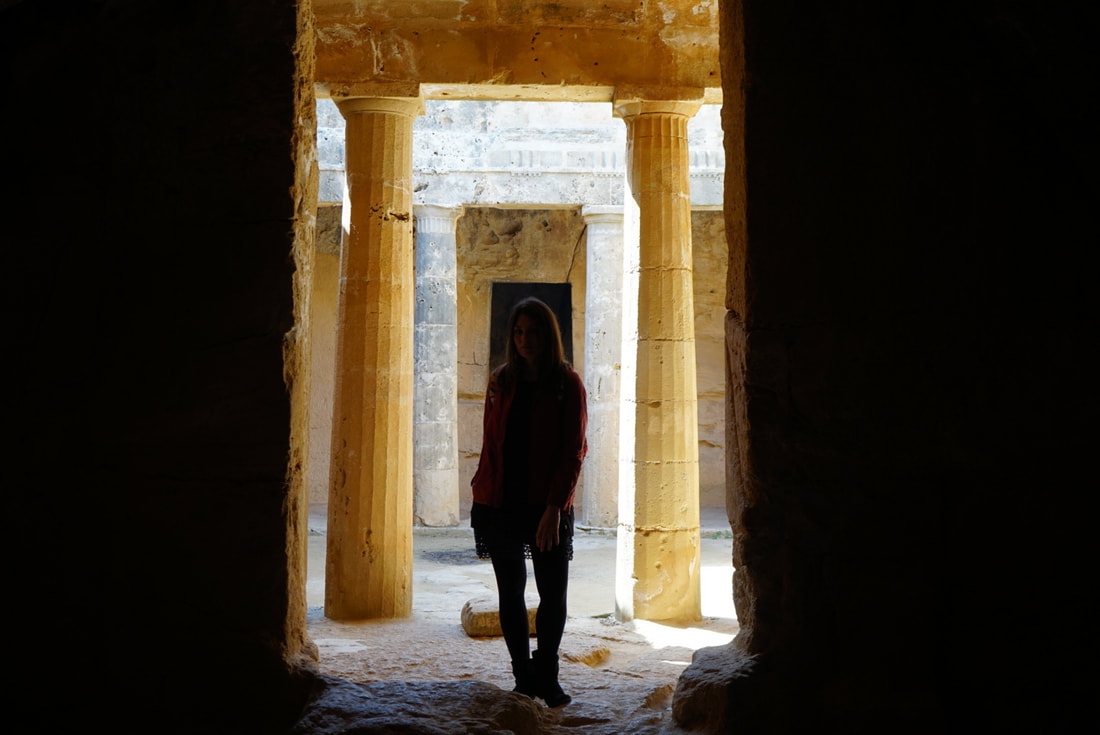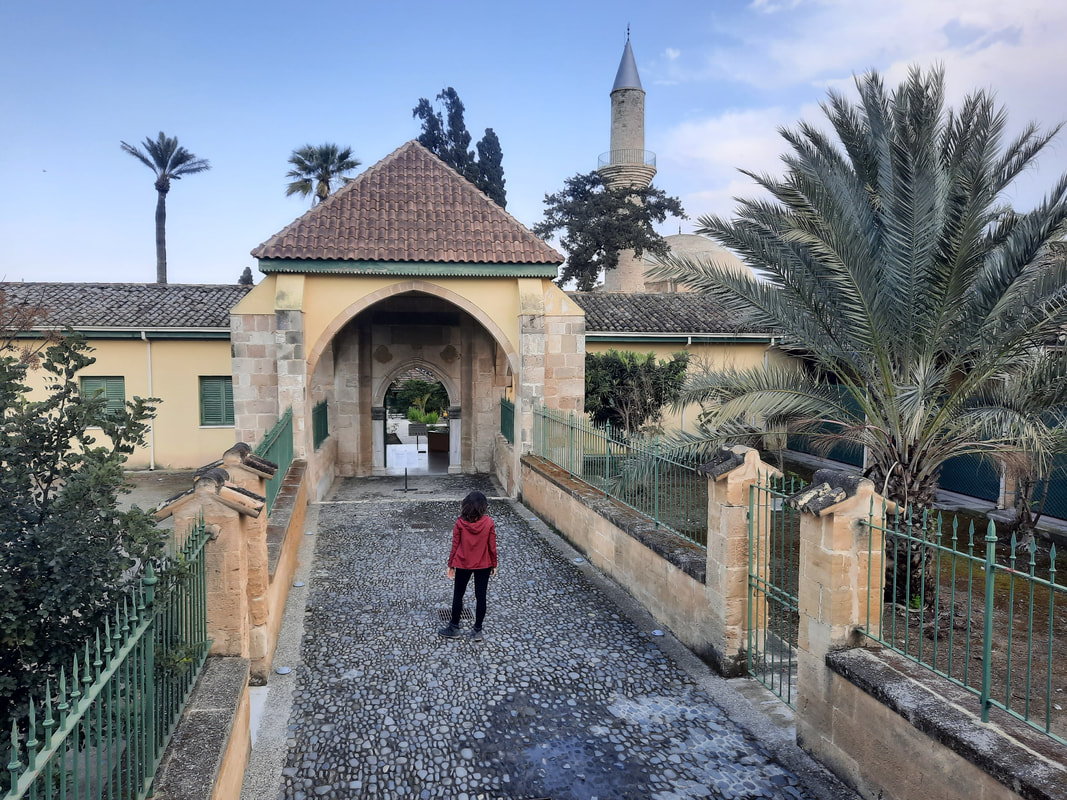Cyprus Nature
Not in the story-mood? Scroll down for the Quick Budget Fact Overview: an itemized information summary of Cyprus! ↓
Sometimes I wonder why I spent such a considerable time in cities when I travel. Convenience, perhaps? A returning need for some civilization and culture to break up the episodes of remoteness and greenery? I definitely don’t want to downgrade the brilliance of the many cities I have visited, but it's in fact the natural endeavours that most prominently stick to my memory. Take Cyprus, for example. Towns like Nicosia or Kyrenia are undoubtedly worth your time and undivided attention, and UNESCO Heritage remnants of ancient civilizations are crucial elements of this island’s character and global significance… But it's the panoramas of the Troodos Mountains and Five Fingers Peak, the slippery endeavours through the Avakas Gorge and the staggering coastal hikes towards Cape Greco that will be recounted numerous times when people ask me “what Cyprus is like.”
Natural Highlights of Cyprus
Natural Highlights of Cyprus
Troodos National Park
Hiking & Skiing
You might think of Cyprus as the island of lavishly blue seas and white coastlines… but the most prominent element is undeniably the Troodos Massif, revealing an alternative character of this diverse destination. The largest mountain range of the country stands as a silent witness of Cyprus’ origins: As a result of a collision between the African and European tectonic plates, a large chunk of igneous rock was pushed upwards… causing the Troodos Mountains to slowly rise from the sea until an island was formed. Nowadays, the surface is carpeted with rich forests containing 750 plant species (of which 12 indigenous), forming the home of precious protected bird life. Needless to say, the crisp mountain air, the first-class vistas and variety of marked hiking trails effortlessly attract nature-enthusiasts who gladly exchange the standard beach relaxation with some outdoors adventures.
Overview of trails:
Hiking & Skiing
You might think of Cyprus as the island of lavishly blue seas and white coastlines… but the most prominent element is undeniably the Troodos Massif, revealing an alternative character of this diverse destination. The largest mountain range of the country stands as a silent witness of Cyprus’ origins: As a result of a collision between the African and European tectonic plates, a large chunk of igneous rock was pushed upwards… causing the Troodos Mountains to slowly rise from the sea until an island was formed. Nowadays, the surface is carpeted with rich forests containing 750 plant species (of which 12 indigenous), forming the home of precious protected bird life. Needless to say, the crisp mountain air, the first-class vistas and variety of marked hiking trails effortlessly attract nature-enthusiasts who gladly exchange the standard beach relaxation with some outdoors adventures.
Overview of trails:
Most trails start from Troodos Square, where the visitor centre is located. Buses allegedly go here from all major cities, but my personal experience can’t confirm that statement. I got up at 6:30AM to catch the 8AM bus from Nicosia / Lefkoşa. It never showed up. Eventually I could take Bus 505 to Kakopatrio and hitchhike the last part: not ideal, as Greek Cypriots aren’t as keen on taking hitchhikers as their northern neigbours.
Popular trails include the Atalanti Trail (14km loop), Psilo Dendro Pouziaris Trail (9km loop) and Artemis Trail (7km loop). The good / bad news is (depending on my audience): Due to the limited elevations and almost “too-well-taken-care-off” trails, it never gets too challenging. Even the “climb” towards the country’s highest peak, Mount Olympos (1952m), can be considered an easy family day out when started from the visitor centre at Troodos Square. Difficulty can be obtained by starting at lower elevations to secure steeper inclines, which also prolongs the distance. There are in fact several multi-day long distance trails present in Cyprus: The most famous one is probably the European Long-Distance Path E4, which crosses from Spain through Gibraltar, France, Switzerland, Germany, Austria, Hungary, Romania, Bulgaria, Greece and it eventually ends in Cyprus. The entire trail is an impressive 10,450km, but the Cypriot stretch covers 640km. Needless to say, completing this trail requires excellent physical fitness as well as thorough planning, as wild camping is officially illegal in Cyprus (although definitely possible, especially in the northern side.) On the northern side, you can hike the multi-day Beşparmak Trail (scroll down to the Five Finger Mountains section).
The best hiking season is spring, when climates are moderate and wildflowers embellish the landscapes. Autumn is another decent alternative. Summer-hiking is not only exhausting due to the extremely high temperatures, but also not so rewarding as the unforgiving sun will turn the scenery into a dry brown ensemble.
Popular trails include the Atalanti Trail (14km loop), Psilo Dendro Pouziaris Trail (9km loop) and Artemis Trail (7km loop). The good / bad news is (depending on my audience): Due to the limited elevations and almost “too-well-taken-care-off” trails, it never gets too challenging. Even the “climb” towards the country’s highest peak, Mount Olympos (1952m), can be considered an easy family day out when started from the visitor centre at Troodos Square. Difficulty can be obtained by starting at lower elevations to secure steeper inclines, which also prolongs the distance. There are in fact several multi-day long distance trails present in Cyprus: The most famous one is probably the European Long-Distance Path E4, which crosses from Spain through Gibraltar, France, Switzerland, Germany, Austria, Hungary, Romania, Bulgaria, Greece and it eventually ends in Cyprus. The entire trail is an impressive 10,450km, but the Cypriot stretch covers 640km. Needless to say, completing this trail requires excellent physical fitness as well as thorough planning, as wild camping is officially illegal in Cyprus (although definitely possible, especially in the northern side.) On the northern side, you can hike the multi-day Beşparmak Trail (scroll down to the Five Finger Mountains section).
- Find all Troodos Trails here.
- More info about the Cypriot section of the European Long-Distance Path E4 here.
The best hiking season is spring, when climates are moderate and wildflowers embellish the landscapes. Autumn is another decent alternative. Summer-hiking is not only exhausting due to the extremely high temperatures, but also not so rewarding as the unforgiving sun will turn the scenery into a dry brown ensemble.
It might come as a surprise from a Mediterranean island such as Cyprus… but in winter Mount Olympos transforms into a tiny ski resort. The resort consist of two areas, the Sun Valley and North Face area, and is operational from December to March. Keep in mind that although the slopes are short and the options are limited, this is definitely not a budget activity. Find the up-to-date prices here.
Hills of Wine
Besides forming the main hiking hotspot and only ski location of Cyprus, Troodos appeals to a very diversified pallet of travel needs with its UNESCO-listed monasteries and rustic mountain villages dotted with local wineries. Yes, you read that correctly: Cyprus knows its wine and contains 50+ wineries! What doesn’t this island have? Archeaological evidence suggests that winemaking has been a local trade since 6000 years (!) and it has been a major facet of the Cypriot diet ever since, with only a temporary decline during the (Muslim) Ottoman occupation. The switch from Ottoman to British rule brought a revival to the Cypriot wine industry, with a strong wave of expansion when Cyprus was one of the only locations in Europe that steered clear from the phylloxera infestation (destroying vineyard roots). Another boom was caused by the production of low-quality bulk wine to be sold to the Soviet Bloc. After this export market vanished due to the communist collapse, more quality-driven strategies were implemented, including the introduction of new grape varieties and investments in small wineries. Nowadays, the most well-known local varieties include the Mavro and Xynistery grapes, with the Commandaria wine being the most exported.
Hills of Wine
Besides forming the main hiking hotspot and only ski location of Cyprus, Troodos appeals to a very diversified pallet of travel needs with its UNESCO-listed monasteries and rustic mountain villages dotted with local wineries. Yes, you read that correctly: Cyprus knows its wine and contains 50+ wineries! What doesn’t this island have? Archeaological evidence suggests that winemaking has been a local trade since 6000 years (!) and it has been a major facet of the Cypriot diet ever since, with only a temporary decline during the (Muslim) Ottoman occupation. The switch from Ottoman to British rule brought a revival to the Cypriot wine industry, with a strong wave of expansion when Cyprus was one of the only locations in Europe that steered clear from the phylloxera infestation (destroying vineyard roots). Another boom was caused by the production of low-quality bulk wine to be sold to the Soviet Bloc. After this export market vanished due to the communist collapse, more quality-driven strategies were implemented, including the introduction of new grape varieties and investments in small wineries. Nowadays, the most well-known local varieties include the Mavro and Xynistery grapes, with the Commandaria wine being the most exported.
Photos by Miles Watson Photography. Fun fact: The Commandaria won the Battle of Wines: The world’s first recorded wine tasting organized in the 13th century by King Philip Augustus from France.
Exploring the local goodies at a selection of Cyprus’ wineries is an almost obligated activity for any wine-lover being lucky enough to set foot on the island. Whereas I normally provide guidelines to initiate such activities budget-style on your own initiative by car or public transport, this is a rather different story when it comes to wine tourism. Drinking and driving is not only a risky endeavour, it also is strictly against the law and can get you in serious troubles on your holiday. Therefore, I recommend booking a tour to safely be dropped off at a selection of wineries without having to worry about sipping one too many. I had an excellent experience with Cyprus Taste Tours, who not only focused on the best Cypriot wine, but also threw some culture and a local food-experiences into the mix.
The tour kicked off at the Oenou Yi locale in Omodos, linked to the Ktima Vassiliades Winery. Accompanied by a generous snack platter we were presented with consecutively a white Xinisteri 2020; a refreshing Pomara 2021; a light ‘n bright Playiá 2021 dry rosé; a powerful dry red Maratheftiko 2018; a dry Playiá Cuvée Spéciale; a sweet red Thalero 2021 (moscat variety); and the Cyprus-special: the Commandaria dessert-wine. Of all seven, it’s the sublime Maratheftiko that stood out the most for me – what a wine! A bit looser than how we started, we set off to explore the rustic charm of the mountain village Omodos, which is a tourist attraction on its own with sights such as the Timios Stavros Monastery and its accompanying museum, the vivid Omodos Square… and in tune with the rest of the afternoon: one of Cyprus’ oldest surviving ancient wine presses (taking up an entire room).
After an abundant lunch of typical local delicacies* such as haloumi cheese, tahini pie and şeftali kebab we moved on to the next and last winery located in Koilani: Ayia Mavri. Where Oenou Yi had a clean, young and trendy vibe to it, this traditional family-run winery made for an entirely opposite experience… much adored by the group! The tasting was as generous as the previous, our taste buds being subjected to a fresh semi-sweet Thymeses 2020 white; a remarkably dry Lefkada 2019; a soft dry Cabernet Franc rosé; an accidentally-created sweet Shiraz (the grapes ripened longer than planned); a tooth-breaking sweet Commandaria 2014; and the Ayia Mavri’s masterpiece… the Mosxatos 2019: A sweet moscat rosé, winner of a sequence of golden medals. That’s right, 100% chance of taking a bottle home (there’s something to suit every budget, from €6-1000).
Get your Cyprus Wine Adventure started!
* Scroll down to the “Budget Bites” section of the Fact Overview to find more local food
Exploring the local goodies at a selection of Cyprus’ wineries is an almost obligated activity for any wine-lover being lucky enough to set foot on the island. Whereas I normally provide guidelines to initiate such activities budget-style on your own initiative by car or public transport, this is a rather different story when it comes to wine tourism. Drinking and driving is not only a risky endeavour, it also is strictly against the law and can get you in serious troubles on your holiday. Therefore, I recommend booking a tour to safely be dropped off at a selection of wineries without having to worry about sipping one too many. I had an excellent experience with Cyprus Taste Tours, who not only focused on the best Cypriot wine, but also threw some culture and a local food-experiences into the mix.
The tour kicked off at the Oenou Yi locale in Omodos, linked to the Ktima Vassiliades Winery. Accompanied by a generous snack platter we were presented with consecutively a white Xinisteri 2020; a refreshing Pomara 2021; a light ‘n bright Playiá 2021 dry rosé; a powerful dry red Maratheftiko 2018; a dry Playiá Cuvée Spéciale; a sweet red Thalero 2021 (moscat variety); and the Cyprus-special: the Commandaria dessert-wine. Of all seven, it’s the sublime Maratheftiko that stood out the most for me – what a wine! A bit looser than how we started, we set off to explore the rustic charm of the mountain village Omodos, which is a tourist attraction on its own with sights such as the Timios Stavros Monastery and its accompanying museum, the vivid Omodos Square… and in tune with the rest of the afternoon: one of Cyprus’ oldest surviving ancient wine presses (taking up an entire room).
After an abundant lunch of typical local delicacies* such as haloumi cheese, tahini pie and şeftali kebab we moved on to the next and last winery located in Koilani: Ayia Mavri. Where Oenou Yi had a clean, young and trendy vibe to it, this traditional family-run winery made for an entirely opposite experience… much adored by the group! The tasting was as generous as the previous, our taste buds being subjected to a fresh semi-sweet Thymeses 2020 white; a remarkably dry Lefkada 2019; a soft dry Cabernet Franc rosé; an accidentally-created sweet Shiraz (the grapes ripened longer than planned); a tooth-breaking sweet Commandaria 2014; and the Ayia Mavri’s masterpiece… the Mosxatos 2019: A sweet moscat rosé, winner of a sequence of golden medals. That’s right, 100% chance of taking a bottle home (there’s something to suit every budget, from €6-1000).
Get your Cyprus Wine Adventure started!
* Scroll down to the “Budget Bites” section of the Fact Overview to find more local food
The Byzantine UNESCO World Heritage monasteries include the following: Panagia Tou Araka, Panagia Asinou, Agio Ioannis Lampadistis, Agios Nikolaos Tis Stegis, Panagia Podithou, Metamorfosis Sotiros, Panagia Moutoulla, Archangelos, Stavros Agiasmati, Timios Stavros, Panagia Tou Sinti.
Five Fingers Peak / Kyrenia Mountains
The southern side of Cyprus might have the country’s highest peak, but the northern side contains the stunning Five Fingers range, named after its most iconic peak*. Sounds catchy, but to avoid confusion it’s good to mention that the actual name of the peak is Pentadactylos, while the mountain range is also referred to as the Kyrenia Mountains (its highest peak being the Selvili Tepe). The chain’s stretches out 170km along the North Cyprus’ coastline, dramatically rising up out of the sea. Even though the peak itself isn’t that high, the flat surroundings and close proximity to the azure blue Mediterranean seas provide for fantastic look-outs.
There are three main trails swirling through these rugged pine-and cypress-covered mountains, the most spectacular one undoubtedly being the 260-km long Beşparmak Trail. If that sounds like a bit much, fear not: the trail circling around the Five Fingers Peak is only 5km. The only downside is that public transport is basically non-existent… you will need a vehicle to get here, or be comfortable with hitchhiking up.
* The odd shape of the peak triggered a wide variety of very creative legends. If you’re interested in reading those, this page of the North Cyprus tourist board can help.
Five Fingers Peak / Kyrenia Mountains
The southern side of Cyprus might have the country’s highest peak, but the northern side contains the stunning Five Fingers range, named after its most iconic peak*. Sounds catchy, but to avoid confusion it’s good to mention that the actual name of the peak is Pentadactylos, while the mountain range is also referred to as the Kyrenia Mountains (its highest peak being the Selvili Tepe). The chain’s stretches out 170km along the North Cyprus’ coastline, dramatically rising up out of the sea. Even though the peak itself isn’t that high, the flat surroundings and close proximity to the azure blue Mediterranean seas provide for fantastic look-outs.
There are three main trails swirling through these rugged pine-and cypress-covered mountains, the most spectacular one undoubtedly being the 260-km long Beşparmak Trail. If that sounds like a bit much, fear not: the trail circling around the Five Fingers Peak is only 5km. The only downside is that public transport is basically non-existent… you will need a vehicle to get here, or be comfortable with hitchhiking up.
* The odd shape of the peak triggered a wide variety of very creative legends. If you’re interested in reading those, this page of the North Cyprus tourist board can help.
More info on the Beşparmak Trail here.
Other noteworthy sights in the Five Fingers Mountains include the numerous castles nestled on its crest. The Byzantines and Lusignans optimized the strategic elevated locations to establish watchtowers and look-out points. Kantara Castle, Buffavento and the spectacular St. Hilarion can still be visited today. When visiting St. Hilarion (which I truly recommend), you can combine it with a visit to the picturesque mountain village Karmi, which is just a short drive away.
Another hard-to-ignore-sight is the giant Turkish flag painted on the southern slope of this mountain range, visible well into Southern Cyprus up until Troodos. A not-too-subtle middle finger from the Turkish to the Greek side of Cyprus amidst a conflict that might have reached a ceasefire, but is far from being resolved (since 1974).
Other noteworthy natural treasures of North Cyprus include the Athalassa National Forest Park close to Lefkoşa / Nicosia and the donkey-loaded Dipkarpaz National Park in the far tip of the north (only reachable by car). As I did not personally visit these destinations due to limited public transport options in North Cyprus, I cannot further review and advise.
Other noteworthy sights in the Five Fingers Mountains include the numerous castles nestled on its crest. The Byzantines and Lusignans optimized the strategic elevated locations to establish watchtowers and look-out points. Kantara Castle, Buffavento and the spectacular St. Hilarion can still be visited today. When visiting St. Hilarion (which I truly recommend), you can combine it with a visit to the picturesque mountain village Karmi, which is just a short drive away.
Another hard-to-ignore-sight is the giant Turkish flag painted on the southern slope of this mountain range, visible well into Southern Cyprus up until Troodos. A not-too-subtle middle finger from the Turkish to the Greek side of Cyprus amidst a conflict that might have reached a ceasefire, but is far from being resolved (since 1974).
Other noteworthy natural treasures of North Cyprus include the Athalassa National Forest Park close to Lefkoşa / Nicosia and the donkey-loaded Dipkarpaz National Park in the far tip of the north (only reachable by car). As I did not personally visit these destinations due to limited public transport options in North Cyprus, I cannot further review and advise.
Ayia Napa & Cape Greco
Ayia Napa is a 2-faced destination. The town itself comes across as a rather tacky, uncultured party paradise sprinkled with gimmicky night clubs catering to the young and wild, ready to get hammered. Yet, at the same time, its location functions as the prime base for natural endeavours in the spectacular Cape Greco Natural Forest Park*, featuring an extensive network of hiking and cycling trails for the more outdoorsy type of tourist. I couldn’t get my head around these two polar opposites, but they make for a rather fun combination! During the day I laced up my hiking boots and followed the trail along the coastline, leading me passed sea caves and natural arches rising out of the popping blue coastline of the Mediterranean. At night I rewarded myself for my efforts with a headache-guaranteed 2 cocktail + fishbowl combo.
* The Cape Greco Natural Forest Park can also be accessed from Protaras, another popular tourist town.
Ayia Napa is a 2-faced destination. The town itself comes across as a rather tacky, uncultured party paradise sprinkled with gimmicky night clubs catering to the young and wild, ready to get hammered. Yet, at the same time, its location functions as the prime base for natural endeavours in the spectacular Cape Greco Natural Forest Park*, featuring an extensive network of hiking and cycling trails for the more outdoorsy type of tourist. I couldn’t get my head around these two polar opposites, but they make for a rather fun combination! During the day I laced up my hiking boots and followed the trail along the coastline, leading me passed sea caves and natural arches rising out of the popping blue coastline of the Mediterranean. At night I rewarded myself for my efforts with a headache-guaranteed 2 cocktail + fishbowl combo.
* The Cape Greco Natural Forest Park can also be accessed from Protaras, another popular tourist town.
Find the GPS-coordinates of this trail here.
Officially there are 9 Cape Greco Nature Trails, which are further specified here. Looking at it I find that a load of bull though, as you can just start walking in any direction and see wherever the hell that leads you. Somewhere pretty, no doubt. Heading north-east, you’ll make your way towards Cape Greco itself, and you’ll be subjected to spectacular panoramic views from the cliffs, rough vegetation and the keen observer can spot over 71 different animal species (it’s a key bird migration site). You’ll pass an abundant selection of weathered sea caves on your route, but they're best observed from the water side. Unfortunately I visited too early in the season for the boat tours to have kicked off already, but that allowed for green spring landscapes and a still moderate climate (summer can be brutal here). I loved everything about this trek, minus the Blue Lagoon tourist attraction… it’s a prime example of what we humans do best: polluting. Focus on the stretches that aren’t accessible by car, and you’ll notice it’s remarkably clean and pure.
Following the coast in the southern direction you’ll face less challenges in terms of “actual” trails and elevation, but you can explore the long series of beaches this area is famous for. Honestly, the prettiest ones I have discovered during an entire month in Cyprus, with Nissi Beach as the undisputed winner. It honestly looks like they put chemicals in Ayia Napa’s water… how can it be that exquisitely blue?! While on your way, it’s worth having a quick peek at the Makrinossos Tombs, a Hellenistic necropolis.
Fun fact: Cape Greco is the easternmost point of the Republic of Cyprus, as well as of the EU.
Officially there are 9 Cape Greco Nature Trails, which are further specified here. Looking at it I find that a load of bull though, as you can just start walking in any direction and see wherever the hell that leads you. Somewhere pretty, no doubt. Heading north-east, you’ll make your way towards Cape Greco itself, and you’ll be subjected to spectacular panoramic views from the cliffs, rough vegetation and the keen observer can spot over 71 different animal species (it’s a key bird migration site). You’ll pass an abundant selection of weathered sea caves on your route, but they're best observed from the water side. Unfortunately I visited too early in the season for the boat tours to have kicked off already, but that allowed for green spring landscapes and a still moderate climate (summer can be brutal here). I loved everything about this trek, minus the Blue Lagoon tourist attraction… it’s a prime example of what we humans do best: polluting. Focus on the stretches that aren’t accessible by car, and you’ll notice it’s remarkably clean and pure.
Following the coast in the southern direction you’ll face less challenges in terms of “actual” trails and elevation, but you can explore the long series of beaches this area is famous for. Honestly, the prettiest ones I have discovered during an entire month in Cyprus, with Nissi Beach as the undisputed winner. It honestly looks like they put chemicals in Ayia Napa’s water… how can it be that exquisitely blue?! While on your way, it’s worth having a quick peek at the Makrinossos Tombs, a Hellenistic necropolis.
Fun fact: Cape Greco is the easternmost point of the Republic of Cyprus, as well as of the EU.
Akamas Peninsula National Park & Avakas Gorge
The unspoilt Akamas* National Park occupies the north-western tip of the island and stretches out for 230 glorious square kilometres, its (by vehicle) inaccessible rugged nature conserving its inner beauty for us adventurous hikers only. This shielded character provides a suitable base for a wide selection of animal species, such as fruit bats, hedgehogs, vultures and lizards. Those lucky enough to roam the area in flourishing springtime find themselves surrounded by a colorful carpet of wildflowers. Did you know that Akamas contains 39 of Cyprus’ endemic plant species?
As potentially the least developed natural area of South Cyprus, don’t expect to find accommodation options or a thorough tourist infrastructure within the park itself (except for 1 campsite in the north). There are two main entry points into the park. The most convenient one is Poli, providing access to the northern side where most attractions are located, including the Blue Lagoon and Baths of Aphrodite**. Buses (# 622) leave hourly from the main bust station, dropping you off close to the main attractions and the starting points of a variety of trails. The most popular hiking treks include the Adonis, Aphrodite and Smigies Trail. More info here.
* The peninsula bears the name of the son of Theseus: Hero of the Trojan War, as well as the founder of the city-kingdom of Soli.
** In Greek mythology, Cyprus is the birthplace of the Goddess of Love Aphrodite… who rose out of the sea at Aphrodite’s rock: now Petra Tou Romiou National Forest Park. Her background story is less romantic: Cronus castrated his father Uranus and tossed his genitals into the sea. The sperm mixed with the sea foam, and voila, Aphrodite was born.
The unspoilt Akamas* National Park occupies the north-western tip of the island and stretches out for 230 glorious square kilometres, its (by vehicle) inaccessible rugged nature conserving its inner beauty for us adventurous hikers only. This shielded character provides a suitable base for a wide selection of animal species, such as fruit bats, hedgehogs, vultures and lizards. Those lucky enough to roam the area in flourishing springtime find themselves surrounded by a colorful carpet of wildflowers. Did you know that Akamas contains 39 of Cyprus’ endemic plant species?
As potentially the least developed natural area of South Cyprus, don’t expect to find accommodation options or a thorough tourist infrastructure within the park itself (except for 1 campsite in the north). There are two main entry points into the park. The most convenient one is Poli, providing access to the northern side where most attractions are located, including the Blue Lagoon and Baths of Aphrodite**. Buses (# 622) leave hourly from the main bust station, dropping you off close to the main attractions and the starting points of a variety of trails. The most popular hiking treks include the Adonis, Aphrodite and Smigies Trail. More info here.
* The peninsula bears the name of the son of Theseus: Hero of the Trojan War, as well as the founder of the city-kingdom of Soli.
** In Greek mythology, Cyprus is the birthplace of the Goddess of Love Aphrodite… who rose out of the sea at Aphrodite’s rock: now Petra Tou Romiou National Forest Park. Her background story is less romantic: Cronus castrated his father Uranus and tossed his genitals into the sea. The sperm mixed with the sea foam, and voila, Aphrodite was born.
Find the GPS-details for the Avakas Gorge Trail here. Once finishing this, you can continue along the coast towards Coral Bay: find the GPS-details of this continuation here.
The southern side is most famous for the spectacular Avakas Gorge and can be accessed from the villages Peyia. That said, it’s rather easy to get here from Paphos as well: Just take the very frequent bus to Coral Bay (# 615 – schedules here) and switch to the minibus (# 616) that stops close to a trail leading to the gorge (just ask the bus driver). This walking route interestingly leads passed the Necropolis at Meletis Forest, a small archaeological site, before it reaches the entrance of the Avakas Gorge. This canyon came into existence due to a strong stream, carving out the narrow limestone chasm we can traverse today. The most dreamy and photogenic stretch of the trail is unquestionably the first narrow stretch… cork dry in summer, but wet and slippery in winter/spring (waterproof footwear necessary, I got soaked). Unfortunately I was unable to complete the full loop due to collapsed rocks making a chunk of trail rather unsafe to traverse, so I decided to backtrack and return to Coral Bay following the rough and edgy coastline. This route leads passed Lara Beach, a protected green turtle nesting area… unique in the European Union! Another striking sight is the Edro III Shipwreck, which saw its last days in 2011 when a raging storm destroyed it.
The southern side is most famous for the spectacular Avakas Gorge and can be accessed from the villages Peyia. That said, it’s rather easy to get here from Paphos as well: Just take the very frequent bus to Coral Bay (# 615 – schedules here) and switch to the minibus (# 616) that stops close to a trail leading to the gorge (just ask the bus driver). This walking route interestingly leads passed the Necropolis at Meletis Forest, a small archaeological site, before it reaches the entrance of the Avakas Gorge. This canyon came into existence due to a strong stream, carving out the narrow limestone chasm we can traverse today. The most dreamy and photogenic stretch of the trail is unquestionably the first narrow stretch… cork dry in summer, but wet and slippery in winter/spring (waterproof footwear necessary, I got soaked). Unfortunately I was unable to complete the full loop due to collapsed rocks making a chunk of trail rather unsafe to traverse, so I decided to backtrack and return to Coral Bay following the rough and edgy coastline. This route leads passed Lara Beach, a protected green turtle nesting area… unique in the European Union! Another striking sight is the Edro III Shipwreck, which saw its last days in 2011 when a raging storm destroyed it.
Photos by Miles Watson Photography.
Larnaca Salt Lake
I visited the salt lake of Limassol and wasn’t impressed. I visited the one in Larnaca, and hey: that one was really quite pleasant, even though it’s smaller! I wouldn’t go as far as to claim it even slightly competes with Troodos or Akamas… but still, it’s always a pleasant surprise to find a lil’ natural getaway at walking distance from a main city. The most striking feature of this protected area are the migratory flocks of flamingos en masse residing at the lake from November to March, feeding on brine shrimp. When the reserves run out, they continue their journey on to Africa. Besides the colorful pink flamingos, 85 other species of waterbird can be spotted in one of the most important wetlands of the country (until summer hits and the water evaporates).
There’s a trail connecting the lake with the Kamares Aqueduct, an interesting sight when in Larnaca. From here you can continue along the waterfront and circle back towards the city, while passing the Hala Sultan Tekke on your way. This significant Islamic pilgrimage site houses the tomb of Umm Haram, Prophet Mohammad’s foster mother.
Larnaca Salt Lake
I visited the salt lake of Limassol and wasn’t impressed. I visited the one in Larnaca, and hey: that one was really quite pleasant, even though it’s smaller! I wouldn’t go as far as to claim it even slightly competes with Troodos or Akamas… but still, it’s always a pleasant surprise to find a lil’ natural getaway at walking distance from a main city. The most striking feature of this protected area are the migratory flocks of flamingos en masse residing at the lake from November to March, feeding on brine shrimp. When the reserves run out, they continue their journey on to Africa. Besides the colorful pink flamingos, 85 other species of waterbird can be spotted in one of the most important wetlands of the country (until summer hits and the water evaporates).
There’s a trail connecting the lake with the Kamares Aqueduct, an interesting sight when in Larnaca. From here you can continue along the waterfront and circle back towards the city, while passing the Hala Sultan Tekke on your way. This significant Islamic pilgrimage site houses the tomb of Umm Haram, Prophet Mohammad’s foster mother.
Find the GPS-details here.
Quick Budget Fact Overview
Cyprus Facts
Short History Recap
5800-3000 BC: Stone Age --> Farmers, herdsmen and hunters. 3000-2300 BC: Bronze Age. 1225: Achaeans (came at end of the Trojan War, establishing kingdoms). 1100 BC: Phoenicians in Kition (now Larnaca). 709 BC: Assyrians. 560 BC: Egyptians. 522-486 BC: Persians. 332 BC: Allegiance with Alexander the Great / Kingdom of Macedonia. 294 – 58 BC: Ptolemies (Egypt). 58 BC: Romans. Apostle Paul and Barnabas introduced Christianity to Cyprus. 395: Eastern Roman / Byzantine Times. 1192-1489: Franks. Introduction of feudalism: Local wealth for knights, the nobility and the merchants – Common people suffering. 1489-1571: Venetians --> reinforcement of infrastructure / creation of new forts. 1570-1878: Ottoman rule. 1878 – 1960: British, gained after Ottomans lost war with Russia --> built roads and organised government. ’55: Greek Cypriots begin guerrilla war against British for unification with Greece, led by Archbishop Makarios --> ’56 deported, ’59: returns and is elected president. ’60: Independence --> Greek and Turkish Cypriots communities reach agreement on a constitution. Treaty of Guarantee: Britain, Greece and Turkey have right to intervene. ’63: Makarios proposes constitutional changes endangering power-sharing = Inter-communal violence, Turkish Cypriots withdraw from power-sharing. ’64: UN peacekeeping force. Turkish Cypriots withdraw into defended enclaves. ’74: Greek Military junta \ backs coup against President Makarios --> flees. Turkish troops land in north, occupy 1/3 of Cyprus. Greek Cypriots flee: population exchange. "Green Line" = ’63 UN ceasefire line. UN Security Council calls upon Turkey to withdraw troops from Cyrpus, but up until now they refused. ’75: Turkish Cypriots establish independent administration: Denktash president. ’83: Turkish Republic of Northern Cyprus proclaimed, recognised only by Turkey. ’98: EU lists Cyprus as potential member. 2002: UN presents a peace plan: 2 constituent parts / rotating presidency. EU summit in Copenhagen invites Cyprus to join in 2004 if agreed to UN plan --> Otherwise only South Cyprus. Referendums: Plan is endorsed by Turkish Cypriots but rejected by Greek Cypriots. ’08: South €. Ledra Street crossing in Nicosia reopened. ’15: Resume talks on reunification, which end inconclusively in July ' 17. ’20: Anti-reunification nationalist Tatar president north.
Cyprus Facts
- Capital: Nicosia / Lefkoşa
- Language: Greek / Turkish
- Population: ± 1.2 mln
- Sq km: ± 9,251
- Currency: Euro (€) / Turkish Lira (₺)
- Electricity Outlet: Type G / 240 V / 50 Hz (the English one) – check!
- Country Code Phone: + 357
- Emergency Phone: 112
- Visa: Cyprus is EU, but not part of Schengen. Check out the visa requirements here.
- Vaccinations: Covid.
- Climate: Subtropical Mediterranean (Csa / BSh)
- High season: Summer
Short History Recap
5800-3000 BC: Stone Age --> Farmers, herdsmen and hunters. 3000-2300 BC: Bronze Age. 1225: Achaeans (came at end of the Trojan War, establishing kingdoms). 1100 BC: Phoenicians in Kition (now Larnaca). 709 BC: Assyrians. 560 BC: Egyptians. 522-486 BC: Persians. 332 BC: Allegiance with Alexander the Great / Kingdom of Macedonia. 294 – 58 BC: Ptolemies (Egypt). 58 BC: Romans. Apostle Paul and Barnabas introduced Christianity to Cyprus. 395: Eastern Roman / Byzantine Times. 1192-1489: Franks. Introduction of feudalism: Local wealth for knights, the nobility and the merchants – Common people suffering. 1489-1571: Venetians --> reinforcement of infrastructure / creation of new forts. 1570-1878: Ottoman rule. 1878 – 1960: British, gained after Ottomans lost war with Russia --> built roads and organised government. ’55: Greek Cypriots begin guerrilla war against British for unification with Greece, led by Archbishop Makarios --> ’56 deported, ’59: returns and is elected president. ’60: Independence --> Greek and Turkish Cypriots communities reach agreement on a constitution. Treaty of Guarantee: Britain, Greece and Turkey have right to intervene. ’63: Makarios proposes constitutional changes endangering power-sharing = Inter-communal violence, Turkish Cypriots withdraw from power-sharing. ’64: UN peacekeeping force. Turkish Cypriots withdraw into defended enclaves. ’74: Greek Military junta \ backs coup against President Makarios --> flees. Turkish troops land in north, occupy 1/3 of Cyprus. Greek Cypriots flee: population exchange. "Green Line" = ’63 UN ceasefire line. UN Security Council calls upon Turkey to withdraw troops from Cyrpus, but up until now they refused. ’75: Turkish Cypriots establish independent administration: Denktash president. ’83: Turkish Republic of Northern Cyprus proclaimed, recognised only by Turkey. ’98: EU lists Cyprus as potential member. 2002: UN presents a peace plan: 2 constituent parts / rotating presidency. EU summit in Copenhagen invites Cyprus to join in 2004 if agreed to UN plan --> Otherwise only South Cyprus. Referendums: Plan is endorsed by Turkish Cypriots but rejected by Greek Cypriots. ’08: South €. Ledra Street crossing in Nicosia reopened. ’15: Resume talks on reunification, which end inconclusively in July ' 17. ’20: Anti-reunification nationalist Tatar president north.
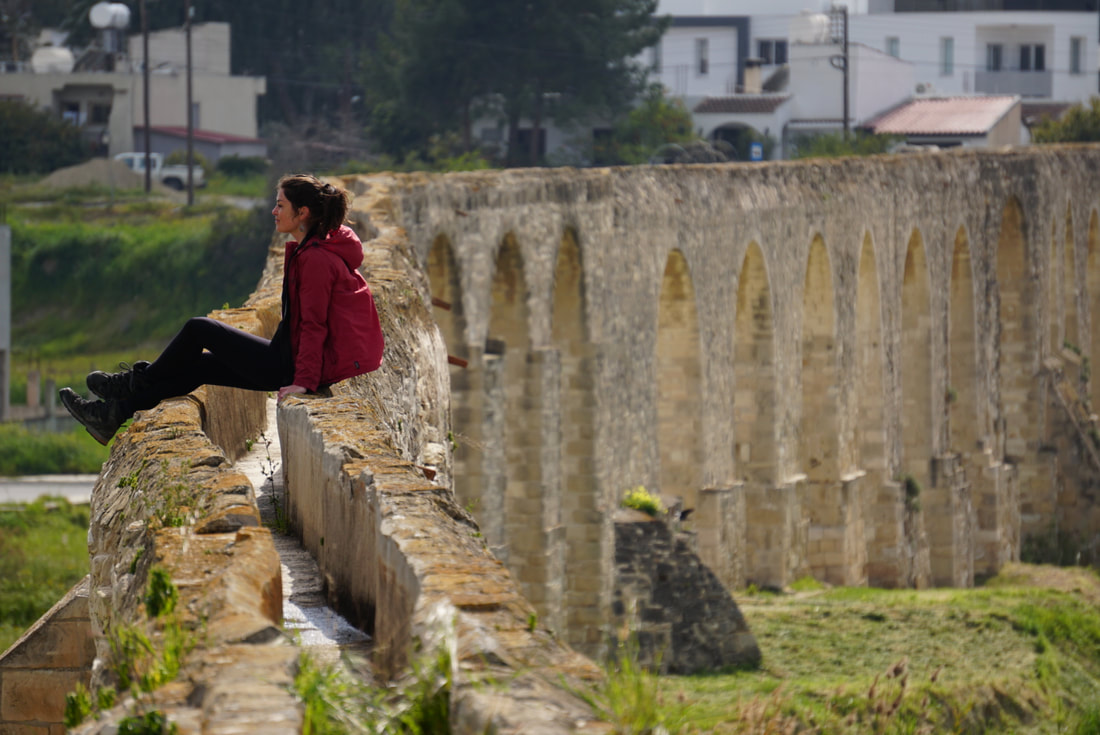
Local Festivals
Budget Bites
- Street Art Festival [Limassol] - May
- Beer Festival [Nicosia] – Jun
- Wine Festival [Limassol] - Aug
Budget Bites
- Budget Supermarkets: Lidl; Plus Discount; Athienitis; Sklavenitis; Metro; AlphaMega.
- Markets: Every city has its own market, usually housed in a separate building. Take note that in Southern Cyprus markets are actually more expensive than supermarkets. In Northern Cyprus markets are definitely cheaper than the supermarkets.
- Local Dishes: Mezze (tapas); Şeftali Kebab (sausages); Kleftiko (roasted lamb meat); Souvlaki (BBQ meat); Moussaka (Greek lasagne); Koupepia / Dolma (rice/meat in wine leaves); Louvi (bean dish); Pilafi Pourgouri (bulgur); Makaoronia Tou Fournou (macaroni lasagne); Stifado (stew); Kotopoulo me Kolokassi (chicken with taro potatoes); Ttavas (claypot dish); Molehiya (dried leaves); Pirohu (cheese / mint pastry); Böreği (pastry); Zeytinli (olive bread); Çörek (sweet bread), Tahinli (tahini bread); Ekmek Kadayıfı (bread pudding); Tarhana (dried wheat / yoghurt); Baf Chewing Gum (natural chewing gum); Ceviz Macunu (walnuts in syrup); Loukomades (deepfried dough balls with honey); Halloumi Cheese.
- The Veg Situation: Going veg is rather complicated in Cyprus, as they love their meat and fish in both the Greek and Turkish side. However, where there’s a will there’s a way. Find all veg-friendly restaurants in this destination here. Local veg dishes: Certain Mezze; Koupepia / Dolma with just rice (vegan); Louvi (vegan); Molehiya (vegan); Pirohu / Böreği with cheese or spinach; Zeytinli; Çörek; Tahinli; Ekmek Kadayıfı; Tarhana; Baf Chewing Gum; Ceviz Macunu; Loukomades; Halloumi Cheese.
- National Drink: Cypriot Wine (commandaria is the most famous); Keo Beer; Zivaniya (pomace brandy); Ouzo (anice-tasting alcoholic beverage); Filfar (liquor); Brandy Sour (cocktail); Ayran (yoghurt drink). Traditional coffee is prepared Turkish style: very strong with the grains still in the cup.
Photo by Miles Watson Photography.
Sleep Cheap
Mama Said
Sleep Cheap
- Hostels / Hotels: Accommodation is incredibly expensive in Southern Cyprus (comparable to Greece), but relatively affordable in the North (although definitely not as cheap as Turkey). If you’re with 2 people or more, a private room or apartment is similarly priced as a dormitory bed in a hostel. I personally found the best deals on Booking.com, which is much cheaper than Air BnB listings here. Booking.com also has the biggest selection, is transparent about the final price and had an efficient search engine tailored to your specific needs. If you use it often enough, generous Genius-discounts are applied. Agoda is often not transparent about prices, adding a lot of additional costs in the last booking-step. Opodo is a better alternative.
- Couchsurfing: allows you to stay with locals. Nowadays it has a moderate sign-up cost (unless you put a third-world country as homebase), but paying extra for verification is unnecessary: Positive reviews are way more important. Once active, there are no costs for staying at someone’s house. In order to get accepted, make sure to write an elaborate request explaining why you applied to this specific profile and think you and your host are a good match (copy-pastes tend to be ignored). In order to avoid the high accommodation costs of Cyprus and meet locals, I made great use of the Couchsurfing communities in both the north and south of Cyprus.
- Housesitting: is an amazing exchange allowing you to stay short- or long-term in somebody’s house, while looking after their house and pets. There are many different websites, most of them paid… but once you landed a sit, the subscription fee pays itself back quickly. The main housesitting site is Trusted Housesitters.
- Wild Camping: is illegal in Cyprus. However, in the northern side it’s not strongly enforced. If you avoid beaches and protected areas, you are unlikely to run into problems.
Mama Said
- Safety: European countries like Cyprus are generally safe, both the north and south, but use your common sense like everywhere. Don’t walk alone in remote areas after sunset, don’t take valuables along and follow your instincts when entering certain neighbourhoods further away from the centre.
- Tap Water: is drinkable.
- The best credit/debit card for traveling is Wise, as they use the live conversion rates without any extra fees. Wise also has the lowest fees for sending money to foreign accounts. Keep in mind that many ATMs charge a fee, the amount always indicated before completing the transaction. Payment by card is generally accepted everywhere.
- Simcard: Keep in mind that a simcard bought in the south doesn’t work in the north, and the other way around. In the South, Epic, Vodafone and Primetel are most used and data prices are amongst the highest in Europe. In the North, Turkcell and Tellsim are the main prepaid networks, and rates are much lower. Whereas Turkey applies restrictions and taxes to foreign mobile phones, this isn’t the case in North Cyprus. EU laws for roaming don’t apply in North Cyprus. In the North you have to register your simcard, whereas in the South you can just buy a sim at any kiosk without registration.
- Some cities have the exact same street name twice, and the same street names are also shared between different cities. Very confusing. Always double-check the address twice before blindly navigating to it (speaking out of experience).
Photo by Miles Watson Photography.
Transport
Next?
Transport
- Walking: Within the cities, most distances can be reached on foot. To reach the suburbs of bigger cities such as Nicosia or Limassol, alternative transport is recommended.
- Cycling: Cycling is an easy option, although traffic can be inconsiderate for cyclists. The bike-share system in the South is called Nextbike (only available in Nicosia and Limassol), in the North it’s Velespeed (available in Nicosia and Famagusta).
- City Buses / Tram / Metro: Cyprus is connected by a bus system. In the South it’s rather organized, with buses leaving on set times advertised online. However, I have experiences of buses not showing up at all. The prices are quite high, but local student discounts apply for intercity buses. Greek Cypriot bus drivers are notoriously grumpy. In the North the bus system is far less organized and rather hectic, operating on a they-come-when-they-come-basis and stopping everywhere along the road. That said, it’s much cheaper. Public transport only connects the main cities… for more remote nature destinations you either need to hitchhike or rent a car.
- Taxi / Uber: The local Uber in Cyprus is Bolt, which operates in the main cities (incl. the northern Famagusta). You can also hail down a taxi on the street, but always negotiate the price before getting in. As expected, it’s more expensive in the South.
- Train: Not available in Cyprus.
- Car Rental: Keep in mind that you often need to pay a fee and/or insurance to move the car from the North to the South. Prices are overall rather high, compared to the rest of Europe.
- Airport: Paphos International Airport (PFO); Larnaca International Airport (LCA); Ercan Arport (ECN) in the North. Cheap city buses run to the neighboring towns, so you can avoid taking a taxi. Keep in mind that if you enter via the South you have to leave via the South, and if you enter in the North you have to leave via the North, otherwise you miss a passport stamp. You can move in between the North and South during your stay without problems, as long as you leave on the side you came from. The North is only recognized by Turkey and their port and airport are internationally recognized as illegal entry/exit points into Cyprus.
- Hitchhiking: is relatively safe and doable in North Cyprus, but not very common in the South.
Next?
In order to support the travelers’ community, I spend many hours per week to adequately document all information and advices for prospective visitors, accompanied by a (hopefully) entertaining insight into my personal observations and experiences. This service is and will remain free. However, if you voluntarily want to make a contribution and support my travels and thus the creation of new stories and information supply, here is the button you’re looking for:
Related:
- Explore Cyprus: Check out the Cyprus Top-5 Cities and the North Cyprus Blogs!
- Get deep into Greece: Athens, Delphi, Arachova, Mount Parnassos NP, Epirus, Meteora, Thessaloniki & Volos
- Archeological treasures, UNESCO sights and Greece's roughest nature: Explore the Peloponnese!
- Skiing on a budget: Romania's top ski resorts!
- Romania's Winter Wonder Land: Sinaia & the Sibiu Region (and sleep in an igloo!)
- Europe's best skiing & hiking: Get your ass over to jaw-dropping Switzerland!
- Check out Budget Bucket List's FAVORITE HIKING DESTINATIONS worldwide!
- The best hiking destinations of Armenia: Mount Aragats, Dilijan and the southern Legend's (Transcaucasian) Trail
- Visit Balkan's finest: Montenegro's National Parks Blog, Kotor Bay & Lovcen NP and Cetinje, Podgorica, Prokletije NP and Montenegro's Coastal Towns Blog
- 10 typical Dutch celebrations no traveller should miss out on
- History preserved: Time capsule of Romanian culture Maramures
- Get your Albania itinerary ready: Berat, Gjirokastër, Korcë / Ohrid Lake, Theth, Shkodër, Tirana, Mount Korab & the coast!
- Be about Bulgaria: Check off Bansko, Belogradchik, Plovdiv, Sofia and of course Veliko Tarnovo!
- Where modern meets classic: Vilnius, Lithuania
- 8 ways to save money in Vienna, Austria
- German gems: Aachen & Frankfurt am Main
- Europe's best skiing & hiking: Get your ass over to jaw-dropping Switzerland!
- Budget Bucket List hitchhike trip to... Kosovo!
- Unravel the mysteries of Serbia
- Discover the splendours of Turkey: Istanbul on a Budget & Reasons to visit Edirne
- Discover the splendors of Macedonian Wine and its best wineries!
- Travel Argentina's main wine regions: Mendoza & Cafayate.
- Explore one of the main wine countries of South America: Chile!
- Carmelo, the main wine destination of Uruguay.
- Go for a bicycle wine tour in New Zealand's North Island & hike the wine route of Cromwell!
- Bosnia & Herzegovina's main wine hub: Trebinje!
- Sample the flavours of Greece in the Epirus wine region.
- Where can you find the best wine of Malta? Read it here!
- Montenegro's main winery is located in... [click here!]
- Get your discounted wine experience in Bucharest, Romania!
- "Con pan y vino se anda el Camino" - the Camino de Santiago passes right through Spain's main wine country! Check it out!
- Explore Cyprus: Check out the Cyprus Top-5 Cities and the North Cyprus Blogs!
- Get deep into Greece: Athens, Delphi, Arachova, Mount Parnassos NP, Epirus, Meteora, Thessaloniki & Volos
- Archeological treasures, UNESCO sights and Greece's roughest nature: Explore the Peloponnese!
- Skiing on a budget: Romania's top ski resorts!
- Romania's Winter Wonder Land: Sinaia & the Sibiu Region (and sleep in an igloo!)
- Europe's best skiing & hiking: Get your ass over to jaw-dropping Switzerland!
- Check out Budget Bucket List's FAVORITE HIKING DESTINATIONS worldwide!
- The best hiking destinations of Armenia: Mount Aragats, Dilijan and the southern Legend's (Transcaucasian) Trail
- Visit Balkan's finest: Montenegro's National Parks Blog, Kotor Bay & Lovcen NP and Cetinje, Podgorica, Prokletije NP and Montenegro's Coastal Towns Blog
- 10 typical Dutch celebrations no traveller should miss out on
- History preserved: Time capsule of Romanian culture Maramures
- Get your Albania itinerary ready: Berat, Gjirokastër, Korcë / Ohrid Lake, Theth, Shkodër, Tirana, Mount Korab & the coast!
- Be about Bulgaria: Check off Bansko, Belogradchik, Plovdiv, Sofia and of course Veliko Tarnovo!
- Where modern meets classic: Vilnius, Lithuania
- 8 ways to save money in Vienna, Austria
- German gems: Aachen & Frankfurt am Main
- Europe's best skiing & hiking: Get your ass over to jaw-dropping Switzerland!
- Budget Bucket List hitchhike trip to... Kosovo!
- Unravel the mysteries of Serbia
- Discover the splendours of Turkey: Istanbul on a Budget & Reasons to visit Edirne
- Discover the splendors of Macedonian Wine and its best wineries!
- Travel Argentina's main wine regions: Mendoza & Cafayate.
- Explore one of the main wine countries of South America: Chile!
- Carmelo, the main wine destination of Uruguay.
- Go for a bicycle wine tour in New Zealand's North Island & hike the wine route of Cromwell!
- Bosnia & Herzegovina's main wine hub: Trebinje!
- Sample the flavours of Greece in the Epirus wine region.
- Where can you find the best wine of Malta? Read it here!
- Montenegro's main winery is located in... [click here!]
- Get your discounted wine experience in Bucharest, Romania!
- "Con pan y vino se anda el Camino" - the Camino de Santiago passes right through Spain's main wine country! Check it out!
